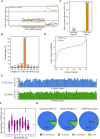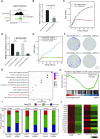A new method to synthesize multiple gRNA libraries and functional mapping of mammalian H3K4me3 regions
- PMID: 36938898
- PMCID: PMC10201432
- DOI: 10.1093/nar/gkad198
A new method to synthesize multiple gRNA libraries and functional mapping of mammalian H3K4me3 regions
Abstract
Genetic screening based on the clustered regularly interspaced palindromic repeat (CRISPR) system has been indicated to be a powerful tool for identifying regulatory genes or cis-elements. However, when applying CRISPR screens to pinpoint functional elements at particular loci, a large number of guide RNA (gRNA) spacers may be required to achieve saturated coverage. Here, we present a controlled template-dependent elongation (CTDE) method relying on reversible terminators to synthesize gRNA libraries with genomic regions of interest. By applying this approach to H3K4me3 chromatin immunoprecipitation (ChIP)-derived DNA of mammalian cells, mega-sized gRNA libraries were synthesized in a tissue-specific manner, with which we conducted screening experiments to annotate essential sites for cell proliferation. Additionally, we confirmed that an essential site within the intron of LINC00339 regulates its own mRNA and that LINC00339 is a novel regulator of the cell cycle that maintains HepG2 proliferation. The CTDE method has the potential to be automated with high efficiency at low cost, and will be widely used to identify functional elements in mammalian genomes.
© The Author(s) 2023. Published by Oxford University Press on behalf of Nucleic Acids Research.
Figures







Similar articles
-
CORALINA: a universal method for the generation of gRNA libraries for CRISPR-based screening.BMC Genomics. 2016 Nov 14;17(1):917. doi: 10.1186/s12864-016-3268-z. BMC Genomics. 2016. PMID: 27842490 Free PMC article.
-
A Molecular Chipper technology for CRISPR sgRNA library generation and functional mapping of noncoding regions.Nat Commun. 2016 Mar 30;7:11178. doi: 10.1038/ncomms11178. Nat Commun. 2016. PMID: 27025950 Free PMC article.
-
GiRAFR improves gRNA detection and annotation in single-cell CRISPR screens.Commun Biol. 2023 Sep 23;6(1):975. doi: 10.1038/s42003-023-05351-7. Commun Biol. 2023. PMID: 37741886 Free PMC article.
-
A Perspective on the Future of High-Throughput RNAi Screening: Will CRISPR Cut Out the Competition or Can RNAi Help Guide the Way?J Biomol Screen. 2015 Sep;20(8):1040-51. doi: 10.1177/1087057115590069. Epub 2015 Jun 5. J Biomol Screen. 2015. PMID: 26048892 Review.
-
Guide RNA library-based CRISPR screens in plants: opportunities and challenges.Curr Opin Biotechnol. 2023 Feb;79:102883. doi: 10.1016/j.copbio.2022.102883. Epub 2023 Jan 3. Curr Opin Biotechnol. 2023. PMID: 36603502 Review.
References
Publication types
MeSH terms
Substances
LinkOut - more resources
Full Text Sources
Research Materials

